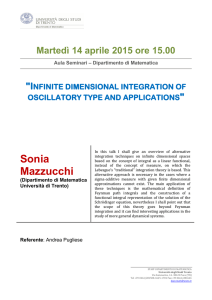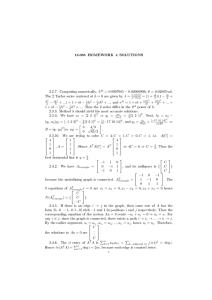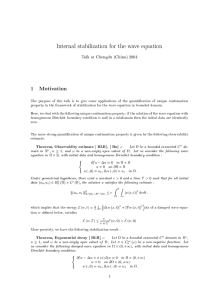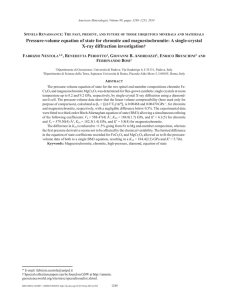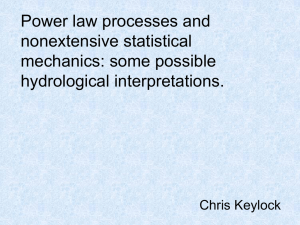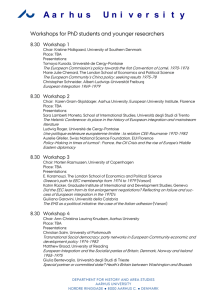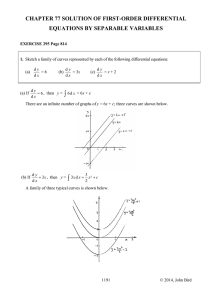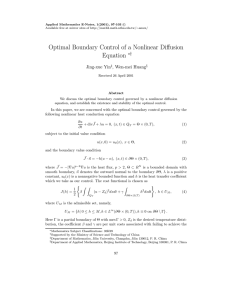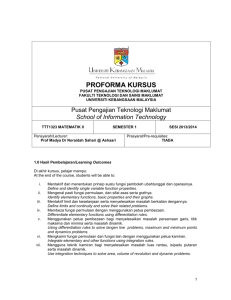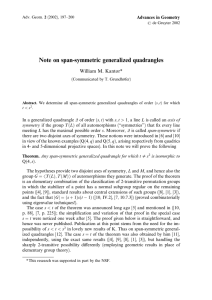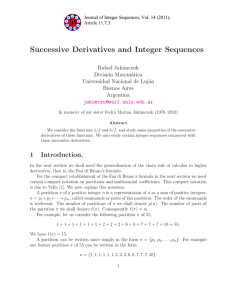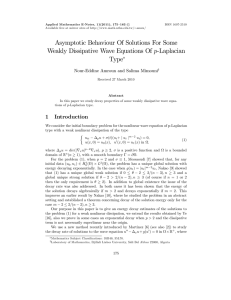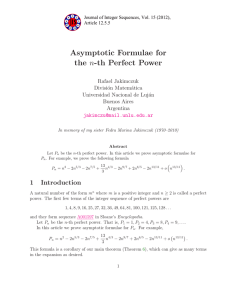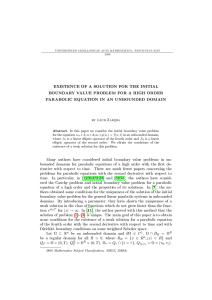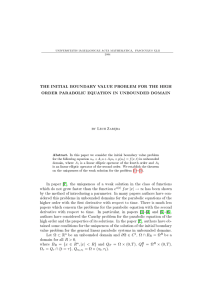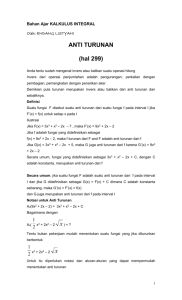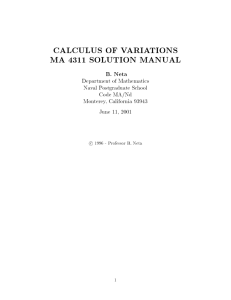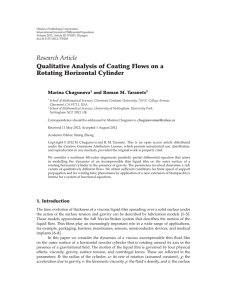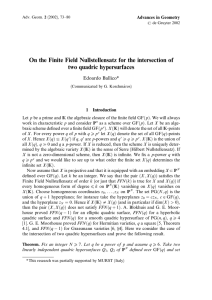Derivation of the Fokker-Planck equation
advertisement
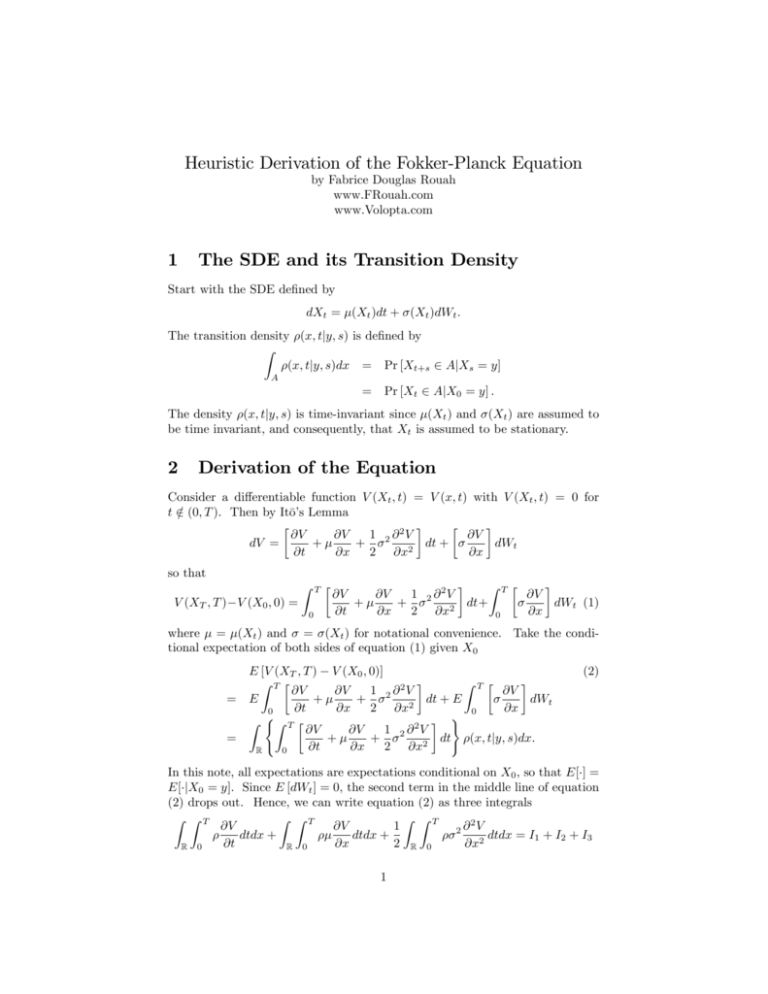
Heuristic Derivation of the Fokker-Planck Equation by Fabrice Douglas Rouah www.FRouah.com www.Volopta.com 1 The SDE and its Transition Density Start with the SDE de…ned by dXt = (Xt )dt + (Xt )dWt : The transition density (x; tjy; s) is de…ned by Z (x; tjy; s)dx = Pr [Xt+s 2 AjXs = y] A = Pr [Xt 2 AjX0 = y] : The density (x; tjy; s) is time-invariant since (Xt ) and (Xt ) are assumed to be time invariant, and consequently, that Xt is assumed to be stationary. 2 Derivation of the Equation Consider a di¤erentiable function V (Xt ; t) = V (x; t) with V (Xt ; t) = 0 for t2 = (0; T ): Then by Itō’s Lemma dV = @V 1 @V + + @t @x 2 so that V (XT ; T ) V (X0 ; 0) = Z 0 T 2@ 2 V dt + @x2 @V 1 @V + + @t @x 2 2@ 2 @V dWt @x V dt+ @x2 Z 0 T @V dWt (1) @x where = (Xt ) and = (Xt ) for notational convenience. Take the conditional expectation of both sides of equation (1) given X0 E [V (XT ; T ) V (X0 ; 0)] Z T Z T @V @V 1 2 @2V @V = E + + dt + E dWt 2 @t @x 2 @x @x 0 0 ( ) Z Z T @V @V 1 2 @2V = + + dt (x; tjy; s)dx: @t @x 2 @x2 R 0 (2) In this note, all expectations are expectations conditional on X0 ; so that E[ ] = E[ jX0 = y]: Since E [dWt ] = 0, the second term in the middle line of equation (2) drops out. Hence, we can write equation (2) as three integrals Z Z T Z Z T Z Z T 2 @V @V 1 2@ V dtdx + dtdx + dtdx = I1 + I2 + I3 @t @x 2 R 0 @x2 R 0 R 0 1 where = (x; tjy; s) for notational convenience. The objective of the derivation is to apply integration by parts to get rid of the derivatives of V: 2.1 Evaluation of the Integrals The trick is that I1 is evaluated using integration by parts on t, while I2 and I3 are each evaluated using integration by parts on x. 2.1.1 Evaluation of I1 @ 0 Use u = ; v 0 = @V @t so that u = @t and v = V . Hence for the inside integrand of I1 we have Z T Z T Z T @V @ @ T dt = V j0 V dt = V dt @t @t 0 0 0 @t since at the boundaries 0 and T , V = 0. Hence Z Z T @ I1 = V (x; t)dtdx: R 0 @t 2.1.2 (3) Evaluation of I2 Change the order of integration in I2 and write it as Z TZ @V I2 = dxdt: @x 0 R Use integration by parts on the integrand, with u = ; v 0 = @( ) @x ; v = V Z Z @( ) @V dx = V jR V dx: @x R R @x Hence the integral can be evaluated as Z TZ @( ) I2 = V (x; t)dxdt 0 R @x Z Z T @( ) V (x; t)dtdx: = @x R 0 2.1.3 @V @x so that u0 = (4) Evaluation of I3 Finally, the evaluation of the integrand of I3 requires the application of integration by parts on x twice. This is because in the integrand we want to get 2 rid of the @@xV2 term and end up with V (x; t) only. Again, change the order of integration and write I3 as Z Z 2 1 T 2@ V dxdt: 2 0 R @x2 2 For the …rst integration by parts use u = 2 ; v 0 = v = @V @x . Hence the integrand can be written Z 2@ 2 2 @V V dx = @x2 R Z = @x R @( 2 ) @V dx = @x @x Z = R so that u0 = @( 2 ) @x and @( 2 ) @V dx @x @x @( ) @V dx: @x @x Apply integration by parts again, with u = Z R R 2 R Z @2V @x2 @( 2 ) 0 @x ; v @( 2 ) V @x + R = Z R @V @x ; u0 = @2( 2) @x2 ; v =V @2( 2) V dx @x2 @2( 2) V (x; t)dx: @x2 This implies that I3 can be written as 1 2 2.1.4 Z 0 T Z R @2( 2) 1 V dxdt = @x2 2 Z Z R 0 T @2( 2) V (x; t)dtdx: @x2 (5) Obtaining the Equation Substitute equations (3), (4), and (5) into equation (2) E [V (XT ; T )] V (X0 ; 0) Z Z T Z Z T @( ) @ V (x; t)dtdx V (x; t)dtdx = @x R 0 R 0 @t Z Z T 2 1 @ ( 2) + V (x; t)dtdx 2 R 0 @x2 Z Z T @( ) 1 @ 2 ( 2 ) @ = + dtdx: V (x; t) @t @x 2 @x2 R 0 Since V (Xt ; t) = 0 for t 2 = (0; T ) we have V (XT ; T ) = V (X0 ; 0) = 0 so that E [V (XT ; T )] V (X0 ) = 0: This implies that the portion of the integrand in the brackets is zero @ @( ) 1 @ 2 ( 2 ) + =0 @t @x 2 @x2 from which the Fokker-Planck equation can be obtained @ = @t @( ) 1 @ 2 ( 2 ) + : @x 2 @x2 3
